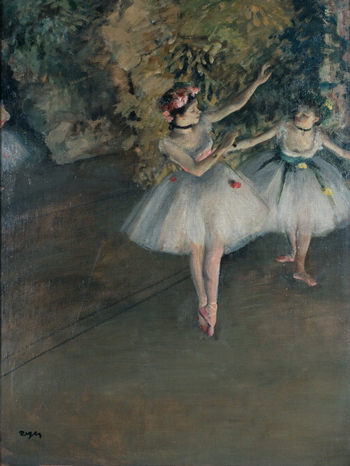
Two Dancers on a Stage

|
Degas was fascinated by the ballet, his extensive series on the subject is a testament to his profound interest. Degas was not only interested in presenting the spectacle of the ballet. He wanted to reveal the artificiality of the performance by focusing on the ambiguous moments which occur at rehearsals or backstage. Two Dancers on Stage presents just this type of moment.
The painting focuses on two dancers in standard ballet positions standing on a stage. Beyond them are stage sets of foliage. The image is seen from above, an unexpected and unusual angle. The viewer is given no clue as to whether the dancers are involved in a performance or a rehearsal. The image is not framed in a coherent manner; a third ballerina on the edge is cut off. These factors help create the ambiguity for which Degas strove.
The stage sets behind the figures are colored freely, while the ballerinas are painted with comparative delicacy. The coloring of the piece is generally subdued, with vivid bursts of pink, yellow and green on the dancers' shoes, flowers, bodices and head-dresses. Degas' use of muted colors stands in contrast to the vivid colors being used by the Impressionists in their landscapes.
Degas wanted to show the visible world from many angles not yet explored in the world of art but characteristic of the modern era in which he lived. With Two Dancers on Stage, Degas takes the viewer into the world of the ballet from a new vantage point. The artist does not entirely reveal the actions of his subjects, but allows the viewer to witness the scene without complete understanding. In this way, he succeeds in challenging artistic traditions and in creating a modern work.












